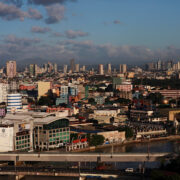PhilHealth hikes premiums to 5%
The Philippine Health Insurance Corp. (PhilHealth) is expecting to rake in around P17 billion in additional funds with the implementation this year of the mandated hike in premiums from 4 percent to 5 percent.
In a press conference on Friday, PhilHealth president and CEO Emmanuel Ledesma announced that the state insurer has finally pushed through with the scheduled increase in members’ contributions a year after it was suspended by President Marcos to provide financial relief to its members.
“For us to be able to sustain these benefit enhancements, PhilHealth needs to continue strengthening its fund,” Ledesma said. “As a key implementer of the UHC (Universal Health Care) law … PhilHealth is bound to implement what was mandated.”
Under Republic Act No. 11223, or the UHC Act, the PhilHealth is mandated to raise members’ premiums by 0.5 percent every year starting 2019. The scheduled increases will end in 2025 when it reaches the second year of the 5-percent limit.
Last year, the state insurer was supposed to raise contributions from 4 percent to 4.5 percent, but this was deferred by the President, citing “socioeconomic challenges.”
Expanded membership
Based on this year’s rates, which took effect on Jan. 1, direct contributors are expected to pay the new premium rates ranging from P500 to P5,000, depending on the income level. This means the income ceiling of members was raised from P90,000 to P100,000, while the income floor was retained at P10,000.
Indirect contributors, or those incapable of paying premiums, are automatically enrolled to the National Health Insurance Program. These include indigents identified by the Department of Social Welfare and Development, Pantawid Pamilyang Pilipino Program beneficiaries, seniors, unemployed persons with disabilities as well as the rest of adults “without capacity to pay premiums.”
Domestic workers, or “kasambahays,” are also entitled to PhilHealth benefits as they are considered direct contributors. But if their monthly salary is below P5,000, the employer should cover 100 percent of their premiums, according to Lemuel Untalan, PhilHealth’s vice president for member management group.
“Our estimate is that at least 17 billion would come into PhilHealth to cover whatever benefits we plan [to roll out] this year,” Untalan said.
While Ledesma maintained that the fiscal position of his agency remained “strong and robust,” he stressed the need to “fund the proposed rationalization and expansion of benefits to ease the burden of the Filipino people in times of medical need.”
But should there be a directive from Mr. Marcos in the coming days to again halt the contribution increase, Ledesma expressed confidence that his agency could still pursue plans to expand at least six benefit packages.
Ready for suspension
“In the event [Mr. Marcos]makes a sudden order to stop [the increase] … we give up the P17 billion,” he said. “But since we’ve been working hard … and PhilHealth has a good cash position, nothing will be affected. I don’t think any of the programs and the packages … will be affected.”
Rey Baleña, PhilHealth senior manager for corporate communications, told the Inquirer that the state insurer’s reserve fund remains intact at P359.29 billion. The agency has yet to complete its financial report for 2023.
The state insurer is set to roll out this year more improved case rates for various illnesses, such as chemotherapy for lungs, liver, ovarian and prostate; dengue hemorrhagic fever; bronchial asthma, material sepsis of newborn, ischaemic heart disease and cataract extraction.
“On top of that, PhilHealth is looking [at] reviewing all case rates in 2024. This is prompted by the increasing costs of healthcare brought about by inflation,” Ledesma said.
As of June 2023, about 104 million people are registered as PhilHealth members, accounting for 92 percent of the country’s projected population of 112 million Filipinos for the same year.
Meanwhile, at least P46.5 billion had been paid by PhilHealth to partner health facilities, both public and private since August last year, Ledesma noted.
Of the running total, P26.2 billion were paid to private facilities, while the remaining P20.3 billion were paid to government facilities.
The current average turnaround time for the processing of claims is at 27 days, according to PhilHealth. INQ















